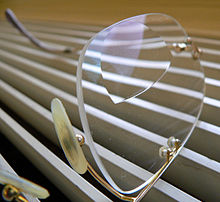Bifocal glass
A bifocal lens is a lens that achieves two ( bi “two”; focal, focus “focal point”) optical effects and can therefore be used for two different distances. Such glasses can be recognized by the dividing line between the two lenses . Accordingly, glasses with bifocal lenses are called bifocal glasses .
Benjamin Franklin is considered to be the inventor of bifocal glasses . It was annoying for him to constantly swap his distance glasses for reading glasses . Around 1770 he came up with the idea of installing two spectacle lenses on each side (R / L) with a corresponding optical effect, the so-called Frankling glass. The first patent was granted to the American Orford in 1909. Today, bifocal glasses are made with two different types of glass: A piece of glass with a higher refractive index is melted into the carrier glass, which is kept at long range . This enables a smooth surface without a noticeable transition between the far and near parts.
Bifocal lenses are also available in plastic materials. The optically different effect of the far and near part cannot be achieved by using different materials, but only by the surface design. This creates a protruding, tangible edge between the two starch parts.
If the difference between distance and near value is greater, a third strength can also be incorporated to supplement the visual areas. In this case, the near segment is divided into two areas, creating a trifocal lens .
The reading part of bifocal glasses is manufactured in different widths. Common dimensions are 25 mm, 28 mm and up to 40 mm for special requirements (the wider and the more special, the more expensive). A Frankling glass or "Executive" glass offers continuous subdivision.
An alternative to bifocal glasses are so-called varifocal glasses , which are becoming increasingly popular.
Bifocal glasses are the treatment of choice for the clinical picture of hypo- accommodative convergence excess and other accommodative-related strabismus diseases with a large convergent near angle.
Individual evidence
- ↑ Modern progressive lenses - conception and production ( Memento from December 2, 2013 in the Internet Archive )
- ^ Herbert Kaufmann, Heimo Steffen: Strabismus. 4th edition, p. 238, Georg Thieme Verlag, Stuttgart, New York 2012, ISBN 3-13-129724-7
